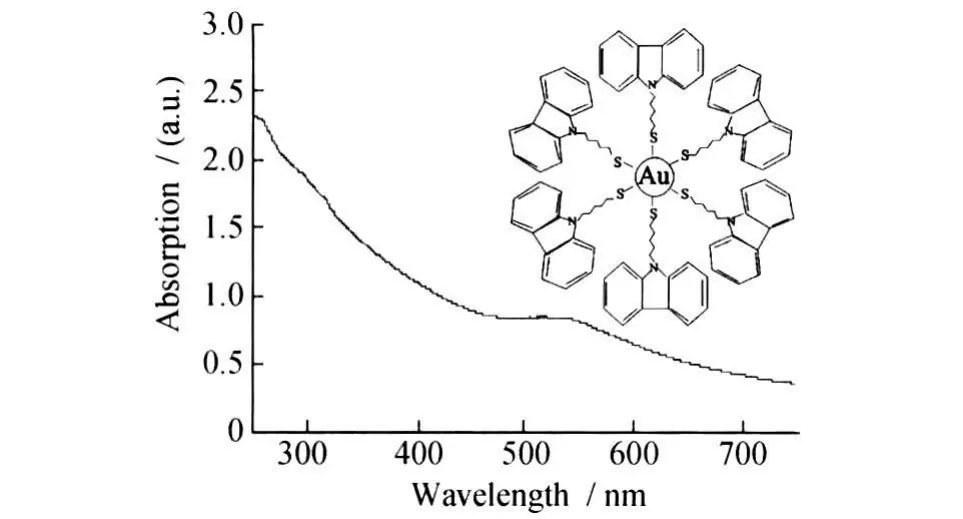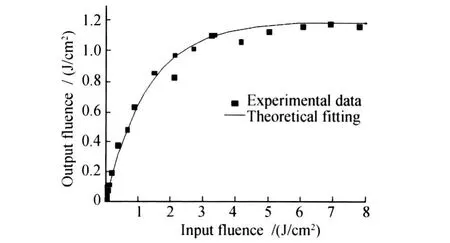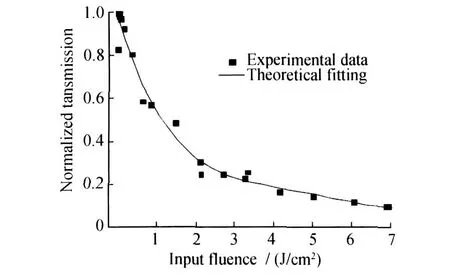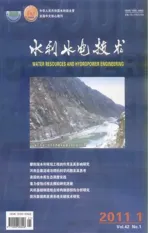咔唑保护的金纳米粒子的光限幅性质研究
2011-03-19高亚臣芦泓宇王艺盟
高亚臣,芦泓宇,王艺盟
(黑龙江大学 黑龙江省电子工程高校重点实验室,哈尔滨 150080)
Ⅰ Introduction
The development of fast response optical limiters for eye and sensor protection is of current interest and has motivated intense research efforts to investigate nonlinear optical systems and various materials with ideal optical limiting(OL)performances[1].Different kinds of materials,such as fullerenes[2-4],metallophthalocyanines[5-6]and inorganic clusters[7-8],have been extensively reported. Recently,nanomaterials have emerged as a new class of OL materials.For example,some semiconductor nanoparticles[9-10],carbon black suspensions(CBS)[11-12],carbon nanotubes[13-14],have been found to exhibit excellent OL responses.In addition to nanomaterials above,metal nanoparticles such as Au,Ag,Pt have attracted considera-ble attention owing to their enhanced OL properties and stability[15-19].However,up to now,there are no reports on the OL of the gold nanoparticles protected by 9-(5-thiopentyl)-carbazole,denoted as CZ-Au for simplicity.
This paper reports the OL properties of the CZ-Au in dimethylbenzene using 532nm laser radiation and analyzes the OL effects by using a model based on Mie extinction theory.The mechanistic issues concerning the OL behavior of CZ-Au are discussed.
Ⅱ Samples and Experiments
The sample of CZ-Au is synthesized using self-organization,as reported in reference[20].The structure of the sample is shown in Fig.1.

Fig.1 Linear absorption spectrum and structure of CZ-Au nanoparticle
The diameter of the gold nanoparticles is estimated by transmission electron microscope(T EM) to be in the range of 30 nm to 50 nm.As is shown in Fig.1,the linear absorption spectrum of the sample in CHCl3 exhibits a surface plasmon resonance(SPR)absorption band(max at 546 nm), which is the characteristic of gold nanoparticles.
The OL properties of CZ-Au in dimethylbenzene are measured with laser pulses from a frequency-double Q-switched,model-locked ns/ ps Nd:YAG laser system,which provides linearly polarized 8 ns(FWHM)laser pulses at 532 nm, with a repetition rate of 1 Hz.The spatial profile of the pulse is nearly Gaussian.The solution sample with linear transmittance of 84%,housed in a quartz cell with a thickness of 2mm,is positioned at the focus of a lens with a focal length of 30 cm. Two detectors,D1 and D2(Rjp-735 energy probe,Laser Precision),are used to monitor the input and output energy,respectively.
Ⅲ Result and Discussion
The experimental results of OL properties of CZ-Au in dimethylbenzene are shown in Fig.2 and Fig.3.At low input fluence,the optical responses of the CZ-Au solution obey Beer's law. Namely,output fluence increases linearly with the increase of input fluence.At relatively high energy,output fluence increases nonlinearly and slowly,and is clamped at a level of 1.1 J/cm2when input fluence increases up to 7 J/cm2.T he threshold fluence for OL is around 0.9 J/cm2.

Fig.2 OL curve for CZ-Au nanoparticle at 532 nm
Additionally,from the results of the normalized transmission,as shown in Fig.3,the transmission decreases by 90%when the input fluence varies from 0 to 7 J/cm2.Obviously,CZ-Au exhibits strong OL,and even compares well to the results obtained with some novel materials such as:Ag-dendrimer nanocomposite materials[19](where a transmission drop of 62%was obtained when the input fluence varied from 0.7 to 10.0 J/ cm2),PVP-stabilized platinum nanoparticles in methanol[18](exhibiting a transmission loss of 90%for a input energy increase up to 3.5mJ),and single-walled carbon nanotube suspensions[14](providing a threshold fluence of≈2 J/cm2and a transmission decrease of 70%for input fluence increasing up to 6 J/cm2).

Fig.3 Normalized transmission at 532 nm versus the input influence for CZ-Au nanoparticle
In order to study the OL mechanisms of CZAu further,the OL of 9-(5-thiopentyl)-carbazole(denoted as CZ for simplicity)in dimethylbenzene is also measured,but it is hard to observe the OL effects of CZ.So the strong OL of the CZ -Au in dimethylbenzene is mainly due to the contributions of the gold nanoparticles.
The following discussions try using a model based on the Mie extinction theory to analyze the OL in CZ-Au.Mie was the first to describe quantitatively all electric and magnetic multi-pole oscillations in using effective extinction cross section composed of absorption and scattering.For nanoparticles is smaller compared to the wavelength λ of the exciting light,only the dipole term of the Mie equation is considered to contribute to the absorption(dipole approximation).In the quasi-static regime the extinction coefficient αfor N particles of volume V is then given by the following equation[21].

Where λ is the wavelength of light,εmthe dielectric constant of the surrounding medium.ε1(ω) and ε2(ω)are the real and imaginary parts of the dielectric function of nanoparticle,respectively(ε (ω)=ε1(ω)+iε2(ω),where ωis the angular frequency of the exciting radiation).
Combining Eq.(3.1)with light transmission equation:dI/dz=-α I,we obtain the OL model for small metallic nanoparticles[18],as is show n in Eq.2,which is valid to describe the OL of small metallic nanoparticles for SPR,interband and intraband transitions.

where T is the nonlinear transmission of the sample,ILthe output intensity,Iothe input intensity, T0the linear transmission of the sample,β2the first-order nonlinear attenuation coefficient (which depends on the species of metallic nanoparticle and excitation wavelength),n″attenuation index,and b=(n′2-n″2+2εm)/2n′(n′is the real part of the refractive index of the sample).
As is shown in Eq.(3.2),the output facet intensity ILof the sample is the concealed function of the input facet intensity I0.It is necessary to calculate numerically Eq.(3.2)to get IL(= TI0).When taking 1+2n″/b=1.123,β2/n″= 0.03 GW/cm2,there shows theoretical curves of OL properties and normalized transmission at 532 nm for CZ-Au,as shown in Fig.2 and Fig.3, respectively.Apparently,there is a pretty fine agreement between the theoretical curve and the experimental data,which indicates that the main origins of the OL of CZ-Au can be attributed to the SPR absorption and(or)nonlinear scattering.
L.Francois and coworkers have observed that the smaller gold particles of 5 nm in average diameter exhibit no limiting response towards nanosecond laser pulses even at high fluence,whereas the larger nanoparticles with average diameter of 30nm are strong limiter[16].Although the absorption properties of gold nanopaticles are dependent on particle sizes,only by such dependence it′s hard to justify the rather strong effects on optical limiting. So the result may be explained further by considering the contribution of nonlinear scattering.In the experiments,the laser wavelength of 532 nm is near the SPR peak of 546 nm,which makes the SPR absorption occur easily.Following the SPR absorption is the vaporization or fragmentation of the gold particles inducing a large light-scattering center around the initial nanoparticles[22].Consequentially,nonlinear scattering can occur strongly. As a mater of fact,there shows a increased beam scattering at large angles with the naked eyes at detector D2 aperture.Since the diameter of the CZ -Au nanoparticles used in experiments is 30 to 50 nm,larger than those previously reported(about 30 nm in average diameter)[16],stronger OL is observed.This further confirms that the OL in gold nanoparticles is size-dependent[16],and the absorption-induced scattering plays an important role in the OL.However,we can not rule out the effects of surfactant.More work concerning that is in progress.
For further confirming the experimental result,the experiment several times under the same conditions is repeated,but no different results appear.This indicates that the experiment results are believable,and the sample is stable.
Ⅳ Conclusions
We report the OL properties of the CZ-Au nanoparticle in dimthylenzene.Strong OL performances are observed.It gives rise to a large transmission loss of 90%.By using a model based on Mie extinction theory,we describe the OL effects.Experimental data and theoretical analysis indicate that the main origins of the OL in CZ-Au nanoparticles are the SPR absorption and the absorption-induced scattering.Gold nanomaterials may represent a new class of potent optical limiters.
Acknowledgements
This work was supported by Foundation from Key Laboratory of Electronics Engineering,College of Heilongjiang Province(DZZD200801),and Foundation from Heilongjiang Province Educational Bureau(11531283).
[1]Lee W.Tutt,Thomas F.Boggess.A Review of Optical Limiting Mechanisms and Devices Using Organics, Fullerenes,Semiconductors and Other M aterials[J]. Prog.Quant.Electr.,1993,17:299-338.
[2]L.Tutt,A.Kost.Optical Limiting Performance of C60and C70Solution[J].Nature,1992,365:255-256.
[3]Q.Gong,Y.Sun,Z.Xia,et al.Nonresonant Thirdorder Optical Nonlinearity of All-carbon Molecule C60[J].J.Appl.Phys.,1992,72:3 025-3 026.
[4]W.J.Blau,H.Byrne,D.J.Cardin.Large Infrared Optical Response of C60[J].Phys.Rev.Lett.,1991, 67(11):1 423-1 425.
[5]J.W.Perry,K.Mansour,I.-Y.S.Lee,et al.Organic Optical Limiter with A Strong Nonlinear Absorptive Response[J].Science,1996,273(5 287): 1 533-1 535.
[6]S.L.Qu,Y.Chen,Y.X.Wang,et al.Enhanced Optical Limiting Properties in a Novel Metallophthalocyanine Complex(C12H25O)8PcPb[J].Mater.Lett., 2001,51:534-538.
[7]S.Shi,W.Ji,X.Q.Xin.Synthesis and Superior Third-Order Nonlinear Optical Properties of the Cluster (n-Bu4N)4[Mo8Cu12O8S24] [J].J.Phys.Chem., 1995,99:894-899.
[8]H.Hou,D.Long,X.Xin,et al.Solid State Synthsis,Crystal Structure,Decomposion Reaction,and Optical Nonlinearity of A Twin-Nest-Shaped Cluster Compound[EtN]4[Mo2O2S6Cu6I6] [J].Inorg.Chem., 1996,35:5 363-5 367.
[9]Shi,K.Zhi,L.Zhang.Preparation and Optical Properties of a SiO2Film Containing In0.2Ga0.8As Nanocrystals by Radio-Frequency Magnetron Co-Sputtering[J]. Thin Solid Films,1998,335:64-69.
[10]W.L.Jia,Elliot P.Douglas,F.Guo,et al.Optical Limiting of Semiconductor Nanoparticles for Nanosecond Laser Pulses,Appl[J].Phys.Lett.,2004,85 (26):6 326-6 328.
[11]C.M.Lawson,G.W.Euliss,R.R.Michael.Nanosecond Laser-Induced Cavitation in Carbon Microparticle Suspensions:Applications in Nonlinear Interfacxe Switching[J].Appl.Phys.Lett.,1991,58(20): 2 195-2 197.
[12]K.Mansour,M.J.Soileau,E.W.Van Stryland. Nonlinear Optical Properties of Carbon-Black Suspensions(ink) [J].J.Opt.Soc.B,1992,9(7): 1 100-1 109.
[13]L.Vivien,E.Anglaret,D.Riehl,et al.Single-Wall Carbon Nanotube for Optical Limiting[J].Chem. Phys.Lett.,1999,307:317-319.
[14]S.R.Mishra,H.S.Rawat,S.C.Mehendale,et al. Optical Limiting in Single-Walled Carbon Nanotube Suspensions[J].Chem.Phys.Lett.,2000,317: 510-514.
[15]Y.-P.Sun,J.E.Riggs,H.W.Rollins,et al. Strong Optical Limiting of Siver-Containing Nanocrystalline Particles in Stable Suspensions[J].J.Phys. Chem.B,1997,103:77-82.
[16]L.Francois,M.Mostafavi,J.Belloni.Optical Limitation Induced by Gold Clusters.1.Size Effect[J]. J.Phys.Chem.B,2000,104:6 133-6 137.
[17]L.Francois,M.Mostafavi,J.Belloni et al.Optical Limitation Induced by Gold Clusters.2.Mechanism and Efficiency[J].Phys.Chem.Chem.Phys., 2001,3:4 965-4 971.
[18]Shiliang Qu,Yinglin Song,Hanfan Liu,et al.Theoretical and Experimental Study on Optical Limiting in Platinum Nanoparticles[J].Opt.Commu.,2002, 203:283-288.
[19]Radu G.Ispasoiu,Lajos Balogh,Oleg P.Varnavski, et al.Large Optical Limiting from Novel Metal-DendrimerNanocompositeMatericals[J].J.Am. Chem.Soc.,2000,122:11 005-11 006.
[20]Shu Wang,Yuliang Li,Chimin Du,et al.Self-organization of Gold Nanoparticles Protected by 9-(5Thiopentyl)-carbazole[J].Chinese Chemical Letter,2000,12(12):1 141-1 144.
[21]S.Link,M.A.El-Sayed.Spectral Properties and Relaxation Dynamics of Surface Plasma Electronic Oscillations in Gold and Silver Nanodots and Nanorods [J].J.Phys.Chem.B,1999,103:8 410-8 426.
[22]Takami.A,Kurita.H,S.Koda.Laser-Induced Size Reduction of Noble Metal Particles[J].J.Phys. Chem.B.,1999,103:1 226-1 232.
